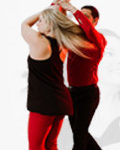How to hitch in west coast swing
If you need to dress up the first two beats of a pattern, the hitch is a great option. The hitch can easily be adapted to multiple styles of music. In bluesy songs, you can add a knee pop to the 1 to create an additional action; in more lyrical songs you can stretch through the hitch to make the dance feel gooey and relaxed.
This post will focus on the technical foundation for the hitch. Next week, we’ll take a look at some styling options in order to dress it up and make it your own.
First, a quick definition. The hitch is simply a delayed weight transfer on the first two beats of the pattern. We normally step on the 1 and 2 of the pattern:
For the hitch, we’re going to delay the first step until the “a” count in the rolling count, or the & in straight time. Normally we use the rolling count to learn hitches because the delayed action on the ball change feels very natural in the rolling count.
If you’ve done other rhythm syncopations, you may recognize that this is the same rhythm as a kick ball-change. The difference between the two is simply what happens with the free leg during the delay. A kick ball-change puts a kick on the downbeat, while the hitch simply continues to stretch.
The Drill:
In this exercise, we’re going to work on continuing the foot action through the hitch. Normally you roll through your anchor foot on the 6&a of the anchor. For a hitch, you’re going to cover the same amount of space on your foot in a longer time: 6&a1. So, the first step is to simply practice doing that rolling action slowly to develop your ability to stretch that roll into the 1.
To practice that extension, put on a slower song with a triple rhythm feel. “I’m the Only One” by Melissa Etheridge is a great song that’s just slow enough to start learning. To really develop control, you’ll want to work into songs in the 60 bpm range, like “Bottom Blues” by Brother Yusef or Albert King’s “Blues Power.” The reason you want a song with the triple rhythm is so it feels natural to move on the a2. With that song playing, dance the six-count rhythm with a hitch on the 1a2. Focus on making sure the anchor foot continues rolling through the entirety of 6&a1, then quickly moving on a2.
Once the feet are rolling, the next step is to check that your center is moving with your feet. It’s tough because your center feels huge and your foot will feel small. This is where keeping your core engaged will help. As you develop control over your center movement, it’ll be easier to feel where your weight is on the foot (i.e., ball, right in front of the arch, over the arch, front of the heel), and then it becomes much easier to practice rolling through 6&a1.
The final piece of the hitch from a technical perspective is integrating the foot roll and center movement with the timing of the stretch. If you’ve practiced stretching your anchor at the end of the slot, you know the feeling of hitting your maximum stretch and using it to power the next motion. Now try to achieve that feeling with the hitch timing, either by yourself or with a partner.
If you practice with a partner, you should be able to feel when your partner is hitching. To test your connection, both partners should dance their normal timing, and one partner is designated to randomly pick a pattern to hitch on. (Hint: since you need to modify your roll through the anchor, make that decision before the anchor of the pattern immediately prior to the hitched 1a2!)
Leaders,
if your follower is hitching you should feel that she is not settled into her anchor enough to lead her forward on 1, and you should be able to sustain your own roll through the anchor until she is ready.
Followers,
if your leader hitches you should be able to feel that he isn’t stretching as quickly as normal and you should thus adjust your own timing to match. (This isn’t to say that you have to match your partner’s timing: it’s fine for one partner to hitch and the other to stick to straight time. But you should be able to feel what your partner is doing, because you’ll want to make adjustments to your lead/follow so that you can do your rhythm without disrupting your partner.)
Ready to add some style to your hitches
If you’ve mastered the basics of hitches and want to take your styling to a different level? Check out our post on adding style to your hitches



 Brian & Megan
Brian & Megan